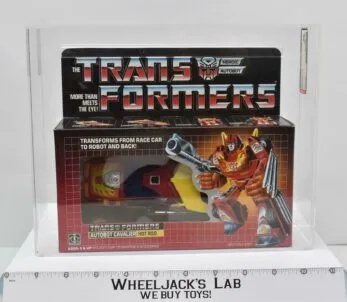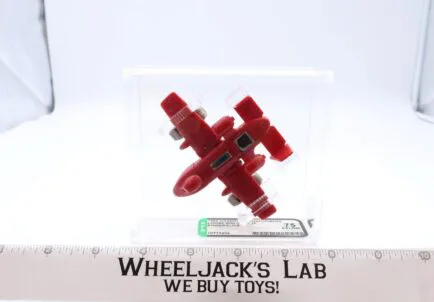Toy grading became widely available in just the late 1900s. For toy collectors, buyers, and sellers, this opened up a whole new world in the vintage toy market. Companies such as AFA (Action Figure Authority) which stemmed off of the CGA (Collectible grading Authority), standardized the metrics for mint toys. They provide services for assessing the condition of vintage and modern toys that remain in perfect or close to perfect condition. These services prove to be very beneficial to many toy collectors, buyers, and sellers. However, some cons and things to consider also arise when it comes to grading your toys. Should you grade your toys? Follow along in our blog to see the pros and cons of AFA grading.
Follow along as we mention some of the pros including standardized grading, increased value, market trust and recognition, authentication, and protection. Likewise, some cons we will mention include the cost, no guaranteed return on investment, long turn around times, potential for damage during shipping, and not making the grade. All of these factor into whether or not you should grade your toys with AFA. See these different factors with us as we dive deeper into each one through the rest of our blog.
Pros
When AFA grading began in the year 2000, a new world of toy grading opened up. This allowed many benefits to toy collectors as well as those wanting to buy and sell toys. With the availability of toy grading services, people now had access to standardized grading, a possible increase in value, growing trust and recognition for certain companies, authentication, and protection for their toys.
Standardized Grading
First up on our blog of seeing the pros and cons to AFA grading, we have the benefit of standardized grading. This company standardized the metrics for mint toys by providing an official grade from the company to help toy buyers and sellers. Before standardizing the grading scale, people depended on their own evaluation of the item’s condition prior to buying and selling. The standardized scale took away the questions through the previous subjective seller descriptions.
Now, people understand these more objective metrics put in place by grading companies and trust their system. The trust plays a huge part into why the standardized grade works so well. With professionals grading the toys, they hold an unbiased and experienced evaluation on your toys. Many people graded their own toys higher than the actual condition of the toy, wanting the value to rise. Likewise, some people selling their toys simply didn’t know how to accurately grade. When professionals grade the toys, it takes the pressure off the seller and ensures a more trustworthy selling process.
AFA created their modern grading scale as well as their standard, qualified, & loose grading scales. AFA’s modern grading scale specifically assess the condition of toys from 1995 to present day. This 10 point scale features bronze, silver, and gold categories. The scale includes more grade options towards the top end of the scale to better determine smaller and harder to determine flaws and ensure a more specific grade for items in mint condition. The standard scale, however, specifically rates the condition of older toys that may have a larger range of possible flaws. Both systems work to produce the best grading results to receive a standardized grade before selling or buying.
Increase in Value

Next up on our blog we will mention how sending your toys to AFA for grading may increase their value. Toys in mint condition may receive a grade higher than 85 and often add great value to the items. Since toys wear very easily due to heat, sunlight, water damage, and dust they often don’t rise in value significantly unless they stay in good condition. Toys that remain in their original factory sealed packaging with little damage and wear often soar in value. Adding to this, when these toys in mint condition receive a professional grade they also return in packaging that keeps the toys in their current condition. This ensures that the toys keep the grade originated by the grading service.
The toy’s release date, rarity, and brand all play into the value of the toy as well. If the mint toys you send in hold rarity in the toy market, they prove more likely to rise significantly in value after grading. Toy buyers looking for a specific item may come across both graded and ungraded toys. The graded toys often come more appealing to the buyer so many people are more likely to pay higher prices. They see the certification, the official grade, and the sealed protection from the company and recognize the value of the toy.
Market Trust
Another benefit on our pros and cons of AFA grading blog includes the market trust and recognition. Amongst grading services, people recognize AFA as one of the most recognizable and reputable services. Since they take the place as a long lasting grading service, many toy collectors, buyers, and sellers put trust in the company. They know the company’s reputation and rely on their grading scale to know the professional outlook on the condition of the toy. People trust AFA’s grading process and know of it’s consistent and reliable assessment through many years of grading. AFA also works to enhance the security of their graded toys. Through their three-step grading process and packaging in acrylic cases, the security of the item stands strong. AFA goes through a three-step grading process including pre-grading, grading, and grading verification to encourage an unbiased and in depth grade that people trust.
Authentication
AFA’s authentication process also stands strong for the company. They use professional graders to evaluate the condition of the toys. AFA uses their junior and senior graders to evaluate each individual toy. They then use their senior graders for the grading verification process, ensuring reliability and experience for each item. Using the standardized scales, the graders also go through a process to ensure consistency and reliability as much as possible.
Also to ensure consistency and fairness in grading, the company looks intently on only the quality of the item. The company keeps their grading the same across the board even if the item holds rarity among the toy market. This also helps keep the grading unbiased as the rare items receive the same grading process as other items only based off the appearance. This grading authentication process allows for buyers’ confidence to rest in knowing that the item went through professional grading and remains free from tampering and wear with the packaging.
Protection

The last pro to mention is protection and preservation when looking at the pros and cons of AFA grading. Through the grading process, each item gets placed in a clear acrylic case. This ensures that the toy remains in it’s current condition when shipped back. Also, since toys wear and show damage incredibly easily, the cases keep the items from getting ruined. The bubble packaging on toys yellows over time with heat and sunlight. Along with this, many toys show signs of water damage, bending, tearing, fading, and dust residue.
The toys stay sealed in the acrylic packaging with the feature of a small opening at the back to allow for air circulation. These acrylic cases also provide some UV resistance which helps protect against yellowing and fading from the sunlight. Along with this, since the figure remains in the acrylic casing, the toy stays protected against any water damage, bending, dust, and other physical damage that might occur otherwise. Lastly, these clear acrylic packages allow for the toy to remain seen entirely for the best possible buying, selling, and toy collecting option.
Cons
Although AFA holds it’s spot as a very recognizable company with a lot of pros, there are some cons to consider as well. The cost of grading, no guaranteed return on investment, and long turn around times all play into this. Other things such as potential for damage during shipping, and some toys not making the grade all play into some cons. Continue following along in our blog on pros and cons of AFA grading with us as we now dive into the cons.
Cost
The cost of grading takes the spot as the first con. Sending your toys to grading services costs money no matter where you send them to. Additional fees and optional service costs all play into how much it costs to send your toy to grading services. Smaller figures usually cost under $50 USD to send while the premium cost usually rises to $100 or more, especially for larger toys. The individual also must pay for shipping if sending it to the grading service. Especially if the item you send in doesn’t receive a high grade, the cost for shipping probably isn’t worth it.
Some items receiving a high grade rise in value and the shipping proves a valuable investment compared to the overall value. However, for many items, the amount of money put into just receiving a grade proves invaluable to the lack of rise in value. Thus, sending your toy to receive a grade makes an impact on the overall value of the toy no matter how much value it holds in the end. The toy cost to send it needs to be subtracted to the value since it took money to ship and send it.
No Guaranteed Return on Investment
As mentioned before, your toy may not gain in value just because you sent it in for grading. The factor of no guaranteed return on investment takes place as another con in grading. While grading proves helpful to some in preserving their toys and increasing the value, many toys show too much wear and cannot receive a good grade. The toy needs to meet certain requirements for AFA to grade the toy. Even then, the toy may receive a low grade, so the value of the toy most likely stays the same.
Along with this, the market demand plays a high role. Even if the toy receives a high grade, there may not be much return on investment due to market demand. Buyers may not search out that specific toy at the time of grading and selling. Therefore, only certain toys gain great value due to what people desire to purchase.
Long Turn Around Times
The long turn around times plays a role on the con side for pros and cons of AFA grading. With AFA, the pre-grading begins after the payment process. This first step of grading includes tiers the customer chooses for turn around times. AFA’s priority tier holds a turn around time of approximately three weeks. Then, the standard tier holds a turn around time of 75+ business days. However, it may take even longer for the customer to receive their toy again. AFA recasing takes around 30 days, where the grading service experts only accept previously graded CGA items to recase.
You may want to take into consideration, then, how long these take to go through the grading process. For some toys of high value receiving a high grade, going through the long grading process may be very beneficial. However, if your toy shows too much wear and doesn’t receive a high grade, it may be too costly and time consuming to gain any benefits or value.
Damage During Shipping
Next up, we will mention the potential for damage on the toy during shipping. Large toys are more likely to become damaged during the shipping process. Even with careful packaging and shipping insurance, the toy may still go through damage. Along with this, bigger items may not last well in the acrylic cases sent back by grading services. These bigger cases can often crack through the shipping process after receiving a grade or over time. Smaller toys may also become damaged through shipping, however, larger toys are more susceptible to it. Therefore, you must carefully consider which toys you send to grading services with the possibility of damage and losing value.
Not Receiving a Grade

The possibility of not receiving a grade takes the last spot on our cons portion of this pros and cons of AFA grading blog. Many toys previously opened, yellowed, bent, or damaged in other ways will not go through the grading process. Although some open and loose or yellowed toys do receive a grade, many do not. The loose and yellowed toys also do not hold up to the higher value of toys in mint condition in their original unopened packaging. Most toys just are not worth grading due to the damage or if they released more recently. Newer toys appear in better condition since they haven’t gone through those extra years of possible damage. However, even older toys may not receive a grade or a high enough grade to gain value from it.
Final Thoughts
Many pros and cons of AFA factor into whether or not you should grade your toys. It stands important to think through and carefully consider each factor to get the best value from your toys. If your toys show significant wear and damage, it won’t be worth it to send your toy in to receive a grade. However, if you happen to own an old toy that remains in excellent condition, it may be well worth it to get your toy graded.
Do You Have Old and Used AFA Graded Toys?
If you have a collection of old and used toys, you can turn those toys into cash. There is no reason to let those old toys collect dust. Contact us today to sell your AFA graded toy collection.
About the Author
Chris Ingledue is the founder and owner of Wheeljack’s Lab pop Culture and Toy Shop. His vision has always been to reunite customers with their favorite childhood toys and pop culture, triggering fond memories, and reigniting their imaginations. Every day he works in the “lab” where it’s Christmas 365 days a year; scouring the internet – like we did the Sears Catalog of yesteryear – for the next great treasure, awaiting the arrival of the postman as if he was Santa Claus himself and helping collectors worldwide with their own versions of Christmas. For Chris, every day as a vintage toy buyer is an absolute joy!